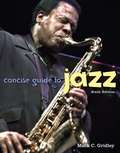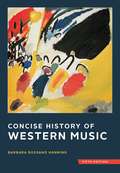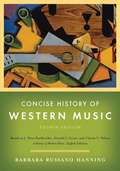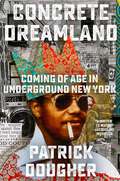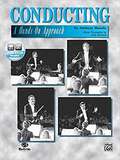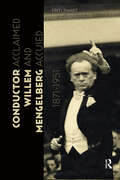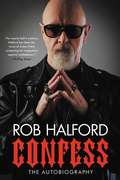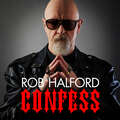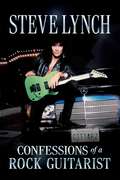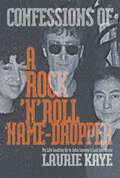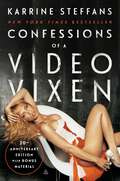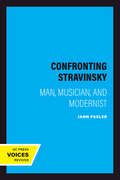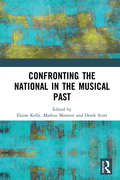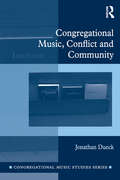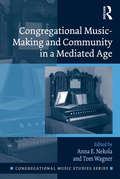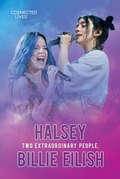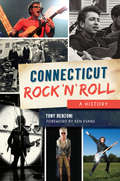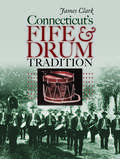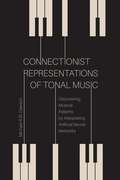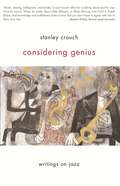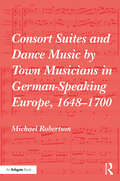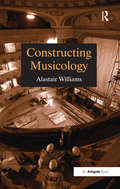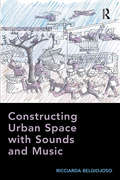- Table View
- List View
Concise Guide to Jazz (6th Edition)
by Mark C. GridleyThe Concise Guide to Jazz provides an introduction to jazz that is as clear and accurate as Jazz Styles but without as much detail. It is a very useful guide for teachers and students.
Concise History Of Western Music
by Barbara Russano HanningBarbara Hanning's Concise History of Western Music offers students a manageable introduction to the forces that shaped music. Combining concision with the imaginative pedagogy that her text pioneered, Hanning focuses on an essential repertoire of 109 characteristic works--from the Middle Ages to the present--providing students with the cultural and historical context to illuminate the music and remember its significance.
Concise History of Western Music (Fourth Edition)
by Barbara Russano HanningBased on A History of Western Music, by J. Peter Burkholder, Donald Jay Grout, and Claude V. Palisca, Concise History of Western Music, Fourth Edition, offers authoritative coverage of the essential works and genres in Western music history. By setting musical events into a memorable historical and cultural context, Concise History of Western Music provides a history students will read and remember.
Concrete Dreamland: Coming of Age in Underground New York
by Patrick DougherFrom an award-winning artist who was featured in Humans of New York comes a bold personal narrative about overcoming family trauma, addiction, poverty—and forging a creative life in the greatest city in the world. Born in Brooklyn in 1963, Patrick Dougher grew up in some of the most turbulent and culturally impactful periods of NYC's history. Often neglected as a child by his parents—a father who struggled with alcohol addiction and an overworked mother who struggled to make ends meet—he learned to fend for himself. Now a renowned visual artist, musician, actor and writer, Dougher brings to the page his memories, struggles, personal revelations, and a life intimately tied to the realities of growing up Black and disenfranchised on the streets of one of the most remarkable cities in the world.Concrete Dreamland is tragic and triumphant, gritty and hard, poetic and outrageously funny. Told in Dougher's brutally raw and courageously honest voice, these stories act as snapshots of a life lived in extremes: from gangsters to God, street style to sexuality, to recovery from drug addiction and alcoholism. He tells of his adventures as a pre-hip hop &“hard rock' and an original Black punk rocker surviving during the dangerous days of the crack and AIDS epidemic in NYC, while also sharing tales of racism, homelessness, and his many brushes with fame and death. Audacious, unique, and moving, Concrete Dreamland is an unforgettable story of addiction, redemption, and life on the streets of a vanishing New York.
Conducting Technique: For Beginners And Professionals
by Brock McElheranThis book starts at the very beginning and ends with some remarkably profound insights on conductorial subtleties. An experienced conductor is one in whom detection, diagnosis, and remedy take place simultaneously; as he hears the error, he realizes where the fault lies and what to do about it. This book gives valuable hints about these three basic conductorial functions from the viewpoint of chorus and orchestra alike. McElheran leads the student toward mastery of the problems at hand, with firmness and gentle humour.
Conducting: A Hands-On Approach
by Anthony Maiello Jack BullockThis comprehensive text by Anthony Maiello on the art of conducting is designed to be hands on, user friendly, playable by any instrumentation, a step-by-step approach to baton technique, great for use with a wind, string or voice conducting class, and excellent as a refresher course for all conductors at all levels of ability. The 232-page book covers a variety of conducting issues and the included recording contains all the musical exercises in the book (there are more than 100).
Conductor Willem Mengelberg, 1871-1951: Acclaimed and Accused
by Frits ZwartWillem Mengelberg is undeniably the greatest conductor in Dutch music history. In his biography, Frits Zwart carefully examines a musical life lived. Mengelberg was not only one of the world’s greatest, he had an excellent reputation as a trainer of orchestral ensembles, responsible for the international reputation of his own Concertgebouw as well as many others including the New York Philharmonic. A champion of numerous composers, including Mahler and Strauss, Mengelberg was the founder of the renowned tradition of annual performances of Bach’s St. Matthew Passion. As Chief Conductor of Amsterdam’s (now Royal) Concertgebouw Orchestra, Mengelberg developed it into one of the world’s most illustrious, simultaneously forging a music life of international eminence for its city of residence. His recordings bear witness to a singular musical interpreter. In 1920, Mengelberg was even more popular than his own Queen, yet a mere thirty years later he died in exile, banned to his remote Swiss chalet. Willem Mengelberg fell from grace, becoming a despised, disputed target of gossip, jealousy and rebuke. His dubious role during World War II has since overshadowed his extraordinary career. Zwart contests that few have ever surpassed Mengelberg‘s international musical legend. In this biography, musicologist and historian Frits Zwart carefully examines in great detail a musical life lived by Willem Mengelberg, undeniably the greatest conductor in Dutch music history. History of the reception in Holland of the music of Gustav Mahler. History of the Concertgebouw orchestra. History of music in Holland. In all this fields many new facts. For the first time a description of Mengelbergs work in New York.
Confess: The Autobiography
by Rob HalfordThe legendary frontman of Judas Priest, one of the most successful heavy metal bands of all time, celebrates five decades of heavy metal in this tell-all memoir.Most priests hear confessions. This one is making his.Rob Halford, front man of global iconic metal band Judas Priest, is a true "Metal God." Raised in Britain's hard-working, heavy industrial heartland, he and his music were forged in the Black Country. Confess, his full autobiography, is an unforgettable rock 'n' roll story-a journey from a Walsall council estate to musical fame via alcoholism, addiction, police cells, ill-fated sexual trysts, and bleak personal tragedy, through to rehab, coming out, redemption . . . and finding love.Now, he is telling his gospel truth.Told with Halford's trademark self-deprecating, deadpan Black Country humor, Confess is the story of an extraordinary five decades in the music industry. It is also the tale of unlikely encounters with everybody from Superman to Andy Warhol, Madonna, Jack Nicholson, and the Queen. More than anything else, it's a celebration of the fire and power of heavy metal. Rob Halford has decided to Confess. Because it's good for the soul.
Confess: The year's most touching and revelatory rock autobiography' Telegraph's Best Music Books of 2020
by Rob HalfordMost priests take confessions. This one is giving his.'The most hotly anticipated hard-rock autobiography of the year''Rob Halford has written one of the most candid and surprising memoirs of the year. . . Confess is a riproaring tale, a funny, often shocking and genuinely emotional story' The Telegraph'The Metal God shares stories from a life like no other, spending over 50 years in the heavy metal bubble, facing adversity head-on but always with a wry smile and horns held firmly aloft' Kerrang'Raw and searingly moving, Confess will delight metal heads and music fans alike' GQ'A unique and deeply revealing insight into the extraordinary life he has led' Metal TalkRob Halford, front man of global iconic metal band Judas Priest, is a true 'Metal God'. Raised in Britain's hard-working heavy industrial heartland he and his music were forged in the Black Country. CONFESS, his full autobiography, is an unforgettable rock 'n' roll story - a journey from a Walsall council estate to musical fame via alcoholism, addiction, police cells, ill-starred sexual trysts and bleak personal tragedy, through to rehab, coming out, redemption... and finding love.Now, he is telling his gospel truth.Told with Halford's trademark self-deprecating, deadpan Black Country humour, CONFESS is the story of an extraordinary five decades in the music industry. It is also the tale of unlikely encounters with everybody from Superman to Andy Warhol, Madonna, Jack Nicholson and the Queen. More than anything else, it's a celebration of the fire and power of heavy metal. Rob Halford has decided to Confess. Because it's good for the soul.
Confess: The year's most touching and revelatory rock autobiography' Telegraph's Best Music Books of 2020
by Rob HalfordRob Halford is the legendary frontman of Judas Priest, one of the most successful heavy metal bands of all time.Known as 'The Metal God' by his devoted, global fan base, Rob Halford has always subverted the norm, and Confess will offer readers a compelling and honest look at the struggles he has faced with addiction and his sexuality as well as exploring his music and his many brushes with controversy. There have been few vocalists in the history of heavy metal whose singing style has been as influential and instantly recognizable as Halford's. Confess, published to coincide with the 50th anniversary of Judas Priest - and described by Halford himself as 'exciting, fun, disturbing and terrifying' - will celebrate five decades of the guts and glory of rock-n-roll.(P) 2020 Headline Publishing Group
Confessions of a Rock Guitarist
by Steve Lynch&“Confessions of a Rock Guitarist is a journey that you'll enjoy... Meeting and connecting with Steve was one of the powerful moments as a musician... His feel, touch, knowledge, enthusiasm and friendship are one that has made me the musician I am today.&” — John Shanks, Grammy Producer of the Year and Six-time Grammy Nominee, Songwriter & Guitarist (Bon Jovi)In Confessions of a Rock Guitarist, Steve Lynch recounts with humility and offbeat humor the struggles he endured growing up in the Pacific Northwest and, later, when he moved to LA to pursue his dream of becoming a professional musician. At the Guitar Institute, a fateful demonstration accelerates the course of Lynch's musical development, transforming him from a student into a master who created a cutting-edge style of his own. Lynch and his band, Autograph, quickly rise to international prominence during the heyday of '80s metal "hair bands." However, addiction, personnel changes, and the public's changing musical tastes threaten to derail his career. Throughout this memoir, Lynch reveals an innate curiosity that takes him around the world as a musician, educator, and seeker of spiritual truth. Illustrated with photographs from Lynch's long and illustrious career, Confessions of a Rock Guitarist is a transcendent record of one man's quest for artistic and personal fulfillment.
Confessions of a Rock N Roll Name Dropper: My Life Leading Up to John Lennon's Last Interview
by Laurie KayeRock reporter Laurie Kaye interviewed John Lennon just hours before he was murdered n 1980 outside New York's famous Dakota apartments and even ran into assassin Mark David Chapman (whom she refuses to cite by name) on the street outside, and here she recounts the story of that fateful night, the centerpiece of this memoir about the life of a SoCal girl with a troubled childhood who got to live out her dream by interviewing many of the most famous rock stars of the time. Name dropping? Well, they say it ain&’t bragging if you really did it and Laurie Kaye has really done it. These stories about so many culturally important people are exciting and illuminating. I read this book with pleasure and amazement. I know that you will dig it, too! Chris Frantz - Drummer/co-founder Talking Heads, Tom Tom Club; author of Remain in Love On December 8, 1980, twenty-something rock journalist Laurie Kaye entered the legendary Dakota apartments on Manhattan&’s Upper West Side to co-conduct an interview with her longtime idol, John Lennon. It was the last interview Lennon would ever give—just hours later, outside that same building, Lennon was shot dead by a twenty-five-year-old man (whom Kaye refuses to refer to by name) whom Kaye herself had encountered after finishing the interview and stepping outside onto the street. Kaye has beaten herself up ever since over her failure to recognize that the assassin—who blocked her path and harassed her with questions like &“Did you talk to him?&” &“Did you get his autograph?&”—posed a danger and should have been reported. Now, as we approach the forty-fifth anniversary of Lennon's death, Kaye reflects how she rose from teen runaway from a dysfunctional family to expatriate studying Balinese dancing in Indonesia to journalist, writer, and producer with credits including RKO Presents The Beatles/The Beatles from Liverpool to Legend (at the tender age of twenty-one) and the Lord of the Rings DVD release, plus interviews with such titans of the music industry as Paul McCartney, George Harrison, Talking Heads, The Ramones, David Bowie, and Mick Jagger, whom she put on hold so that he could listen to her newscast before getting down to business. But it was the day she shared a loveseat with John Lennon and watched him push his iconic granny glasses down the length of his nose and smile at her in agreement that remains indelibly etched in her mind—both the best and worst day of her life. Laurie Kaye began her career in radio at KFRC-AM San Francisco, for years one of the nation&’s greatest top 40 stations, where she started as an intern and worked her way up to on-air reporter and anchor. She wrote and coproduced numerous radio rock specials for RKO, including RKO Presents the Beatles (later expanded and retitled as The Beatles from Liverpool to Legend), and The Top 100 of the 70&’s before moving on to write Dick Clark&’s weekly radio countdown show and syndicated newspaper column. Kaye then moved on to television and film as a writer, producer, and casting director, where she still works today, handling both creative content and line producing for docuseries pilots. This book won a Writer&’s Digest Award the year it was released - 4th place in the Memoir/Personal Essay category of their annual writing competition! Front cover by Grammy-winning artist and director Mick Haggerty.
Confessions of a Video Vixen
by Karrine SteffansPart tell-all, part cautionary tale, this emotionally charged memoir from a former video vixen nicknamed 'Superhead' goes beyond the glamour of celebrity to reveal the inner workings of the hip-hop dancer industry—from the physical and emotional abuse that's rampant in the industry, and which marked her own life—to the excessive use of drugs, sex and bling.Once the sought-after video girl, this sexy siren has helped multi-platinum artists, such as Jay-Z, R. Kelly and LL Cool J, sell millions of albums with her sensual dancing. In a word, Karrine was H-O-T. So hot that she made as much as $2500 a day in videos and was selected by well-known film director F. Gary Gray to co-star in his film, A Man Apart, starring Vin Diesel. But the film and music video sets, swanky Hollywood and New York restaurants and trysts with the celebrities featured in the pages of People and In Touch magazines only touches the surface of Karrine Steffans' life.Her journey is filled with physical abuse, rape, drug and alcohol abuse, homelessness and single motherhood—all by the age of 26. By sharing her story, Steffans hopes to shed light on an otherwise romanticised industry and help young women avoid the same pitfalls she encountered. If they're already in danger, she hopes to inspire them to find a way to dig themselves out of what she knows first-hand to be a cycle of hopelessness and despair.UPDATE: As the music industry started to have its own reckoning with men who've behaved badly, even criminally, Confessions has been discussed in some quarters as an early warning bell, with Karrine as a feminist icon who shined a light when no one wanted her to and championed sex positivity before it was embraced. Now she talks about what it has been like to watch the tide turn and the lessons still to be learned.
Confronting Stravinsky: Man, Musician, and Modernist
by Jann PaslerThis title is part of UC Press's Voices Revived program, which commemorates University of California Press’s mission to seek out and cultivate the brightest minds and give them voice, reach, and impact. Drawing on a backlist dating to 1893, Voices Revived makes high-quality, peer-reviewed scholarship accessible once again using print-on-demand technology. This title was originally published in 1986.This title is part of UC Press's Voices Revived program, which commemorates University of California Press’s mission to seek out and cultivate the brightest minds and give them voice, reach, and impact. Drawing on a backlist dating to 1893, Voices Revived</DIV
Confronting the National in the Musical Past
by Elaine Kelly Markus Mantere Derek B. ScottThis significant volume moves music-historical research in the direction of deconstructing the national grand narratives in music history, of challenging the national paradigm in methodology, and thinking anew about cultural traffic, cultural transfer and cosmopolitanism in the musical past. The chapters of this book confront, or subject to some kind of critique, assumptions about the importance of the national in the musical past. The emphasis, therefore, is not so much on how national culture has been constructed, or how national cultural institutions have influenced musical production, but, rather, on the way the national has been challenged by musical practices or audience reception.
Congregational Music, Conflict and Community (Congregational Music Studies Series)
by Jonathan DueckCongregational Music, Conflict and Community is the first study of the music of the contemporary 'worship wars' – conflicts over church music that continue to animate and divide Protestants today – to be based on long-term in-person observation and interviews. It tells the story of the musical lives of three Canadian Mennonite congregations, who sang together despite their musical differences at the height of these debates in the late 1990s and early 2000s. Mennonites are among the most music-centered Christian groups in North America, and each congregation felt deeply about the music they chose as their own. The congregations studied span the spectrum from traditional to blended to contemporary worship styles, and from evangelical to liberal Protestant theologies. At their core, the book argues, worship wars are not fought in order to please congregants' musical tastes nor to satisfy the theological principles held by a denomination. Instead, the relationships and meanings shaped through individuals’ experiences singing in the particular ways afforded by each style of worship are most profoundly at stake in the worship wars. As such, this book will be of keen interest to scholars working across the fields of religious studies and ethnomusicology.
Congregational Music-Making and Community in a Mediated Age: Singing A New Song (Congregational Music Studies Series)
by Tom Wagner Anna E. NekolaCongregational music can be an act of praise, a vehicle for theology, an action of embodied community, as well as a means to a divine encounter. This multidisciplinary anthology approaches congregational music as media in the widest sense - as a multivalent communication action with technological, commercial, political, ideological and theological implications, where processes of mediated communication produce shared worlds and beliefs. Bringing together a range of voices, promoting dialogue across a range of disciplines, each author approaches the topic of congregational music from his or her own perspective, facilitating cross-disciplinary connections while also showcasing a diversity of outlooks on the roles that music and media play in Christian experience. The authors break important new ground in understanding the ways that music, media and religious belief and praxis become ’lived theology’ in our media age, revealing the rich and diverse ways that people are living, experiencing and negotiating faith and community through music.
Connected Lives: Halsey/Billie Eilish (Connected Lives)
by Saddleback Educational PublishingThemes: Music, Nonfiction, Chapter Book, Hi-Lo, Hi-Lo Books, Hi-Lo Solutions, High-Low Books, Hi-Low Books, ELL, EL, ESL, Struggling Learner, Struggling Reader, Special Education, SPED, Newcomers, Reading, Learning, Education, Educational, Educational Books. Connected Lives, a contemporary nonfiction series for teens, features the fascinating life stories of popular artists. Each book presents two singers in a similar musical genre who have lived extraordinary lives, exploring how their lives interconnect and how they are different. As similar as these artists may seem, their rise to fame may have been very different. Multiple musical genres are represented across the series, including pop, hip-hop, jazz, and country. Graphic elements, such as timelines, charts, and Venn diagrams, are featured in every chapter. Books are 64 pages and full-color.
Connecticut Rock ‘n’ Roll: A History
by Ken Evans Tony RenzoniLong neglected in the annals of American music, the Nutmeg State’s influence on the history of rock’n’roll deserves recognition. Connecticut’s musical highlights include the beautiful harmonies of New Haven’s Five Satins, Gene Pitney’s rise to fame, Stamford’s the Fifth Estate and notable rockers such as Thurston Moore of Sonic Youth, Rivers Cuomo of Weezer and Saturday Night Live Band’s Christine Ohlman. Rock Hall of Famers include Tina Weymouth and Chris Frantz of the Talking Heads and Dennis Dunaway of the Alice Cooper Band. Some events became legend, like Jimi Hendrix’s spellbinding performance at Yale’s Woolsey Hall, Jim Morrison’s onstage arrest at the New Haven Arena and teenage Bob Dylan’s appearance at Branford’s Indian Neck Folk Festival. With in-depth interviews as well as rare, never-before-seen photos, author Tony Renzoni leads a sonic trip that captures the spirit and zenith of the local scene.
Connecticut's Fife and Drum Tradition (The Driftless Connecticut Series)
by James ClarkThe state of Connecticut boasts an extensive and active community of fife and drum groups. This musical tradition has its origins in the small military bands maintained by standing armies in Britain and Europe in the seventeenth and eighteenth centuries--the drum was especially important as it helped officers train soldiers how to march, and was also used to communicate with troops across battlefields. Today fifers and drummers gather at conventions called "musters," which may include a parade and concerts featuring the various participating corps. According to the Guinness Book of World Records, the largest muster ever was held in Deep River, Connecticut, in 1976. Musician and historian James Clark is the first to detail the colorful history of this unique music. This engaging book leads the reader through the history of the individual instruments and tells the story of this classic folk tradition through anecdotes, biographies, photographs, and musical examples.
Connectionist Representations of Tonal Music: Discovering Musical Patterns by Interpreting Artifical Neural Networks
by Michael R. DawsonPreviously, artificial neural networks have been used to capture only the informal properties of music. However, cognitive scientist Michael Dawson found that by training artificial neural networks to make basic judgments concerning tonal music, such as identifying the tonic of a scale or the quality of a musical chord, the networks revealed formal musical properties that differ dramatically from those typically presented in music theory. For example, where Western music theory identifies twelve distinct notes or pitch-classes, trained artificial neural networks treat notes as if they belong to only three or four pitch-classes, a wildly different interpretation of the components of tonal music. Intended to introduce readers to the use of artificial neural networks in the study of music, this volume contains numerous case studies and research findings that address problems related to identifying scales, keys, classifying musical chords, and learning jazz chord progressions. A detailed analysis of the internal structure of trained networks could yield important contributions to the field of music cognition.
Considering Genius: Writings on Jazz
by Stanley CrouchStanley Crouch-MacArthur "genius" award recipient, co-founder of Jazz at Lincoln Center, National Book Award nominee, and perennial bull in the china shop of black intelligentsia- has been writing about jazz and jazz artists for over thirty years. His reputation for controversy is exceeded only by a universal respect for his intellect and passion. As Gary Giddons notes: "Stanley may be the only jazz writer out there with the kind of rhinoceros hide necessary to provoke and outrage and then withstand the fulminations that come back. " Now, in a long-awaited collection, Crouch collects fifteen of his most influential, and most controversial pieces (published inJazz Times, The New Yorker, theVillage Voice, and elsewhere), and includes two new essays as well. The pieces range from the introspective "Jazz Criticism and its Effect on the Art Form" to a rollicking debate with Amiri Baraka, to vivid, intimate portraits of the legendary performers Crouch has known. The first, autobiographical essay reflects on his life in jazz as a drummer, a promoter, a critic, and most of all a lover of this quintessentially American art form. And the closing essay, about a young Italian saxophonist, expresses undaunted optimism for the worldwide vibrancy of jazz. Throughout, Crouch's work reminds us not only of why he is one of the world's most important living jazz critics, but also of why jazz itself remains, against all odds, an elemental component of our cultural identity.
Consort Suites and Dance Music by Town Musicians in German-Speaking Europe, 1648–1700
by Michael RobertsonThis companion volume to The Courtly Consort Suite in German-Speaking Europe surveys an area of music neglected by modern scholars: the consort suites and dance music by musicians working in the seventeenth-century German towns. Conditions of work in the German towns are examined in detail, as are the problems posed by the many untrained travelling players who were often little more than beggars. The central part of the book explores the organisation, content and assembly of town suites into carefully ordered printed collections, which refutes the concept of the so-called 'classical' suite. The differences between court and town suites are dealt with alongside the often-ignored variation suite from the later decades of the seventeenth century and the separate suite-writing traditions of Leipzig and Hamburg. While the seventeenth-century keyboard suite has received a good deal of attention from modern scholars, its often symbiotic relationship with the consort suite has been ignored. This book aims to redress the balance and to deal with one very important but often ignored aspect of seventeenth-century notation: the use of blackened notes, which are rarely notated in a meaningful way in modern editions, with important implications for performance.
Constructing Musicology (Routledge Revivals Ser.)
by Alastair WilliamsThis title was first published in 2001: Unlike many other academic disciplines, musicology has been somewhat reluctant to explore the possibilities that critical theory might offer to our understanding of music and the ways in which we study it. In recent years, however, both the general impact of theory on humanities research and the wider repertoires now studied on music degree courses have urged a paradigm shift in musicology. Looking at both these trends, Alastair Williams examines and explains the theoretical issues raised by different musics, including the Western canon, popular music, folk music and music by women. A theoretically informed musicology, he argues, can reflect on its own procedures and create strategies for particular problems as they arise. In this sense the book offers a musicology under construction. To appreciate how theoretical discourses function and the interests they serve, it is important to understand their roots. Chapter One begins with a presentation of traditional musicology in the context of Joseph Kerman's call for a shift from fact-finding to critical interpretation. Discussion then moves to the scrutiny of the bourgeois tradition by Adorno and Dahlhaus. Chapter Two explores Kerman's critique of structural analysis, together with the impact of poststructuralism on musicology. Awareness of new repertoire and its consequences becomes evident as the book unfolds, with Chapter Three considering music by women and examining how gender is constructed in music. Chapter Four extends this discussion to the field of popular music and the ways in which this genre negotiates identity. Challenges to the dominant values are further explored as Chapter Five looks at how non-European cultures are presented in European music and reflects on perceptions of self and other in ethnomusicology. Chapter Six charts the emergence of modern subjectivity and its formations in music, arguing that musicology should not lose sight of modernity's critical resources.
Constructing Urban Space with Sounds and Music
by Ricciarda BelgiojosoWhile we are used to looking around us, we are less used to listening to what happens around us. And yet, the noises we produce reveal our way of life, and learning to master them is a necessity. This book aims at drawing the reader’s attention to the sound of the urban environment. The topic is by its very nature complex, as it involves sounds and noises, urban space and social activities. Using an interdisciplinary approach, it examines a heterogeneous selection of experimentations from the domains of music, art and architecture. Significant case studies of pieces of music, public art works and scientific research in the field of urban planning are analyzed, investigating the methods that have been adopted and the aural processes that have been generated. It then uses the findings to reconstruct the underlying theories and practices and to show what might be drawn from these procedures applied to urban planning. The overall objective is to learn to build and enrich space with sound, arguing that there is a need to reconsider architecture and urban planning beyond building, and to look to the world of the arts and other disciplines. In doing so, the book guides the reader toward a sensorial architecture, and more generally toward consciously creating environmental architecture which is sustainable and connects with art and which diffuses a culture of sound.
